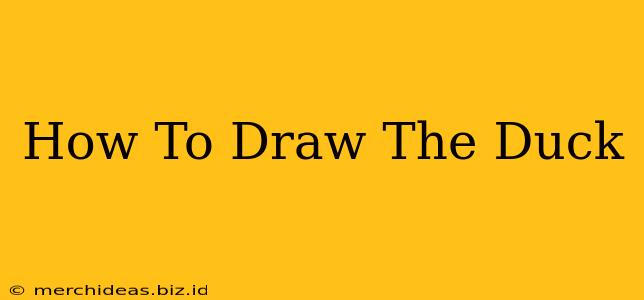So you want to learn how to draw a duck? Fantastic! Ducks are charming, expressive creatures, and drawing them is a rewarding experience, regardless of your skill level. This guide will take you through a simple, step-by-step process, perfect for beginners. Let's get quacking!
Step 1: The Basic Oval Shape
Start with the foundational shape – an oval. This will form the duck's body. Don't worry about making it perfect; a slightly irregular oval adds character. Lightly sketch the oval in pencil; we'll refine it later.
Tips for the Oval:
- Light pressure: Use a light touch with your pencil to avoid creating harsh lines. This allows for easy erasing and adjustments.
- Size and proportion: The size of your oval will determine the size of your duck. Consider the overall composition of your drawing.
Step 2: Adding the Head
Next, add a smaller, slightly elongated oval connected to the larger oval. This will be the duck's head. The connection point should be smooth and somewhat overlapping.
Positioning the Head:
- Angle: Experiment with different angles to create a more dynamic pose. A tilted head can add personality to your duck.
- Overlap: Make sure the head slightly overlaps the body for a more natural look.
Step 3: Defining the Beak
Draw a triangle shape at the end of the smaller oval. This is the duck's beak. You can add a slight curve to the beak to make it look more realistic.
Beak Variations:
- Size and shape: Ducks have different beak shapes. Experiment with different lengths and widths.
- Details: Add a subtle line to split the beak into two halves.
Step 4: Adding the Eyes and Feet
Now, add two small circles for the eyes. Position them on the head, keeping them relatively close together. For the feet, draw two small, webbed feet towards the bottom of the body oval.
Adding Details:
- Eye placement: Place the eyes slightly above the center of the head.
- Foot details: Add small lines to suggest the webbing between the toes.
Step 5: Refining the Shape and Adding Feathers
This step involves refining the overall shape of your duck. Smooth out the lines, making the transition between the head and body more fluid. You can suggest feathers by adding gentle curves and lines to the body and neck.
Feather Suggestions:
- Short strokes: Use short, curved lines to mimic the texture of feathers.
- Varying pressure: Vary the pressure on your pencil to create highlights and shadows.
Step 6: Adding Final Details and Shading
Add any other details you wish to include, such as a small crest on the head, or extra detail to the feet. Finally, add shading to give your drawing depth and dimension. Pay attention to where the light source is coming from to create realistic shadows.
Shading Techniques:
- Hatching: Use closely spaced parallel lines.
- Cross-hatching: Use intersecting lines for darker areas.
- Blending: Use a blending stump or your finger to soften the shading.
Practice Makes Perfect
Remember, practice is key! Don't be discouraged if your first attempt isn't perfect. Keep practicing, experiment with different styles, and you'll soon be drawing ducks like a pro. Have fun and let your creativity flow!
Keywords: How to draw a duck, drawing a duck, duck drawing tutorial, easy duck drawing, simple duck drawing, drawing for beginners, step-by-step duck drawing, animal drawing, how to draw animals, art tutorial, drawing tutorial for kids.
